Above is a video link to my presentation from the Ancestral Health Symposium at UC Berkley. I’ve outlined the presentation below:
“To be interested in food, but not food production, is clearly absurd” – Wendell Berry
Food plays such an important role in all of our lives. Yet, many of us are so disconnected from food production that we are unaware of some of the major social justice issues happening across the globe. Most of us can agree that we don’t want others to suffer for our choices, yet you could be unknowingly supporting practices like human trafficking when you are buying your Halloween chocolate.
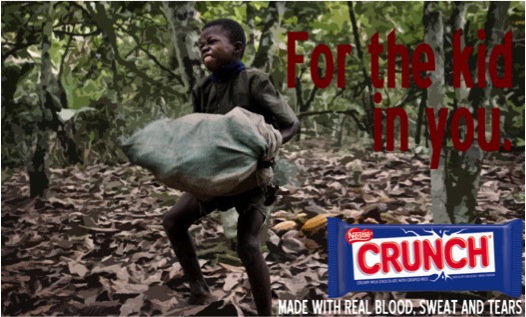
What is “Real Food”?
When we consider a “healthy”, “real food” or “paleo” diet, most people are considering the nutrients in that food, and how it affects them. We look at the back of the package for the ingredients. How many carbs does it have? How much fat? When thinking about the production of the item, the questions often asked are surrounding how it will impact our bodies. Is it organic? Was it grass fed? Most often, the motives behind these questions are to find out how the food will impact our own bodies or our children’s bodies.
Rarely are we asking how the workers were treated, or wondering if that farmer was paid fairly for their produce. Were children sold into slavery so that you can enjoy that chocolate bar? How our purchases are affecting the lives of others rarely comes into play, and it’s mostly because we just aren’t aware of what’s going on in the world food system. In my opinion, “Real Food” should encompass more than just how it will benefit your body, but its impact on the environment, farm workers and communities should also be considered. I really like this image below from the Real Food Challenge (and I love the work they’re doing, but that’s a different post.)
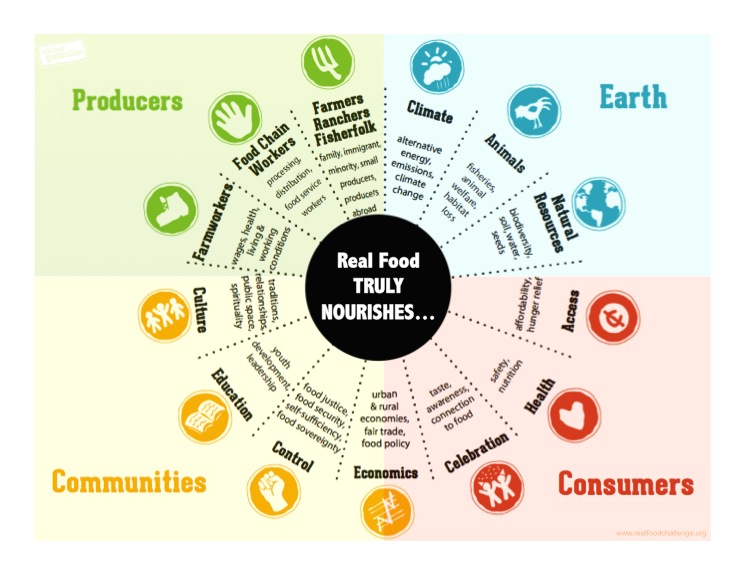
What to Choose?
Labels can be confusing. It’s hard to know what to trust and how to make a good choice. I’ve done some research into three foods that most people on a “healthy” diet commonly consume: bananas, coffee, and chocolate. Behind the grocery store and coffee shop scenes, there are some major problems within these industries that I’d like to share that will enable you to make an informed choice the next time you consider buying your mocha latte or banana on the go.
Bananas
I’ll start with bananas, America’s number one consumed fruit. They’re cheap. The average price of bananas is about $0.60 per pound compared to apples at $1.39 per pound. How can this be? They don’t even grow in this country. The fact is, in most banana producing countries, workers are paid poorly, subjected to harsh chemicals, and children are often part of the work force.
Cavendish = Weak
Today, the variety of banana Americans see in grocery stores is called “Cavendish”. They are grown under mono-cropping conditions on large plantations, and are susceptible to disease. Cavendish bananas are being wiped out by diseases like Panama Disease, which is slowly killing every banana being grown. Companies are racing to develop a new mono-crop to replace Cavendish.

Heavily Sprayed
Because they are so weak, non-organic bananas are heavily sprayed. The chemicals used are often outlawed in the US and Europe, but the laws are more relaxed in many banana producing countries. Poisons like Nemagon, a proven carcinogen banned in the US, was used in the ‘70’s and ‘80’s by Dole, Del Monte and Chiquita. Pesticides are sprayed by workers and by crop dusting airplanes, often landing on neighboring homes and schools. The results are incurable illnesses, human sterilization, and devastating birth defects. Organic bananas are not sprayed, but are still grown in a mono-crop method. Instead of replacing Cavendish with another mono-crop, we should instead seek diversity within the banana industry so that the crop is more resilient to disease.
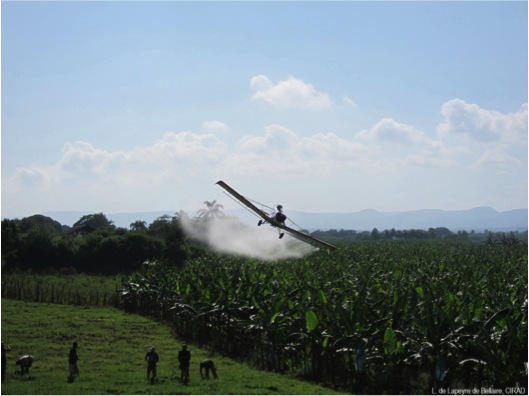
Alternatives:
Good: Organic bananas, “Grow” brand (fair trade, organic bananas distributed on the West Coast.)
Better: Fair Trade bananas, organic bananas from small-scale plantations like “Discovery” (Canada), and “Equal Exchange” (East Coast). Also, seek out varieties other than Cavendish.
Best: Eat organic, locally grown fruit and berries instead of tropical fruits grown in a mono-crop method.
Check out the film “Bananalands” and read the book, Banana by Dan Koeppel
Coffee
Next, let’s look at our beloved beverage, coffee. Unlike bananas, coffee is usually grown on smaller scale family farms which can make it even more difficult to track its origin. It’s the second most traded commodity in the world and four multinational companies dominate the industry: Kraft, Nestle, Proctor & Gamble and Sara Lee.
Coffee Economics:
The highly volatile price of coffee is based on the commodity market and set in New York and London. Since 1990, retail sales of coffee have increased from $30 billion to $80 billion per year. 2.5 billion cups are consumed every day around the world. The average wholesale price for one kilogram of coffee is about 30 cents, passing at least six hands before reaching the consumer.

Supply > Demand
In 2002, 8% more coffee was produced than purchased. Across the globe, farmers aren’t making enough from coffee beans to even feed and clothe their families. Basic needs are simply not being met. Because they are desperately poor, many African farmers are hacking down their coffee plants and replacing them with the drug Khat, which grows in similar conditions and fetches a much higher price. The best options for farmers to grow specialty coffee is to sell to a cooperative, but with coffee plants taking four years to produce beans, this can be a time intensive and expensive transition.
Alternatives
Good: Buy certified fair trade coffee, and ask retailers and coffee shops to stock more fair trade options.
Better: Direct trade certified coffee with third party verification (pays more money directly to the farmers)
Best: Fix your adrenal glands and drink less coffee?
Check out the film “Black Gold”
Chocolate
Finally, I’d like to talk about chocolate, our favorite treat. Cacao plantations in Ghana and the Ivory Coast provide 80% of the world’s chocolate. Like coffee, small farmers generally produce chocolate, which makes it hard to trace its origin. Most chocolate also contains sugar and vanilla, which have their own issues in the global trade market. Organic chocolate is more likely to come from South America. Because of diseases that affect African cacao farms, it’s difficult to grow cacao organically there.
Child Slavery
In many parts of Western Africa, children ranging in age from 10 to 15 are tricked into leaving their small towns with the promise of high paying jobs. Some are simply kidnapped while playing in the street. Traffickers sell these stolen children for as little as $30 a child to cacao farmers and 60% of them are under age 14. Once trapped on the farm, these children work 12 hour days. They climb trees and harvest the cacao beans with large machetes. These children are fed a poor diet mainly consisting of bananas, and are not given healthcare or access to education. Escape is dangerous as they often don’t speak the local language, are unaware of their rights, and are subjected to harsh beatings of captured and returned to the farm.

Cheap Chocolate Holidays
Chocolate is a treat that is enjoyed year round, but in large amounts during holidays such as Christmas, Easter, and Halloween. Halloween is the most chocolate-centered holiday in North America, with 90 million pounds of chocolate candy sold in the week leading up to Halloween. As you can guess, most of the chocolate consumed during this time is produced by companies that are buying from cacao farms in Africa that are not fair trade certified. Campaigns to boycott or reduce the amount of chocolate bought on these holidays would attract the attention of chocolate companies, and prompt a public conversation regarding the issue.
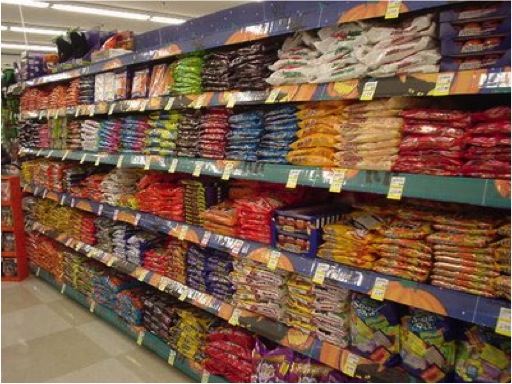
Alternatives:
Good: Look for chocolate from the Caribbean, Central and South America, where child slavery and human trafficking are rare.
Better: Divine Chocolate is 51% owned by farmers in Ghana. It’s not organic but is fair trade. (Because of disease, it’s very difficult to grow chocolate organically in Africa)
Best: Buy chocolate with a FLO, IMO, or Fair Trade certification. There are also direct trade certified companies with third party verification.
Check out the film The Dark Side of Chocolate
Want to learn more?
Other products that you may be buying often and are listed on the Fair Trade International website include: cotton, flowers, fresh fruit, honey, gold, juices, rice, spices and herbs, sugar, tea, and wine.
Get the “Better World” app, and check out your favorite brands before you buy them. Not all fair trade companies are listed, so you can also look for the following logos on your products. If you don’t see the logo, write to the company and request more information. Direct trade, which is third party certified, is also a great option. Again, what you are looking for is transparency, so that you aren’t just taking the company’s word for it. These images below represent just a small sampling of the company ratings through Better World. (So instead of asking me in the comments of this post if your favorite brand is “ok”, check out this app first).
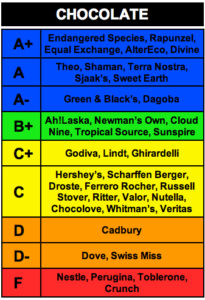
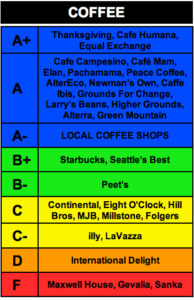
If you’re a food blogger or other influencer in the food world, you have a great opportunity to shape people’s thinking about their ingredients. Consider mentioning the importance of fair trade when you have an ingredient that could be produced under socially unjust ways. If your recipe calls for “chocolate” or “bananas”, you could state “fair trade” before them. If you are a college student, consider joining the Real Food Challenge, an effort to get colleges and universities to purchase “Real Food” (see the diagram at the beginning of this post). I’m happy to report that UC Berkley and the entire UC System has recently joined.
Social justice issues could and should be as important to us as the terms “organically grown” or “grass fed”. As more and more people become aware of how our food is produced, I hope one day the average American will find issues like child slavery completely unacceptable and not purchase chocolate from companies that aren’t transparent with their sourcing.
If you’d like to try some great chocolate, I have reached out to two companies and asked them if they’d provide me with a discount code for my readers. Until September 30th, 2014, you can get a 10% discount through TAZA Chocolate (use code: RADIANCE) and Pure 7 Chocolate (use code: sweet15).
I’d also like to thank Equal Exchange for their assistance as I wrote this article (and please check out their coffee, chocolate and bananas). They are really doing things right.
___________________________________________________________________________
References:
Dan Koeppel (2008). Banana. The Fate of the Fruit that Changed the World. London: Hudson Street Press.
National Fruit and Vegetable Retail Report Vol VIII – No. 26 Friday, June 27, 2014
http://inthesetimes.com/article/2096
Fairtrade.net/coffee
Black Gold: http://blackgoldmovie.com
AFRICA: The Dark Side of Chocolate, Kate McMahon, CorpWatch, 25 October 2005 (retrieved 29 October 2012)
“Sustainalytics | Leading-edge ESG research and responsible investment analysis.” Sustainalytics | Leading-edge ESG research and responsible investment analysis.


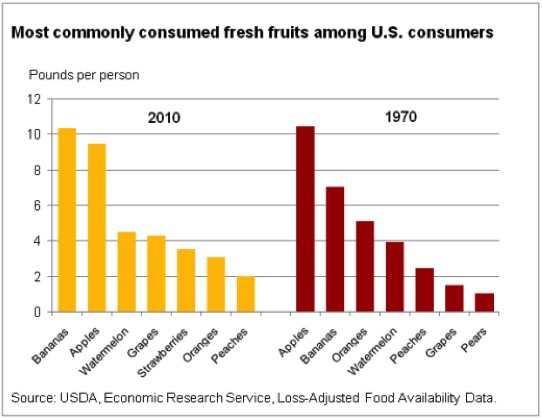






28 thoughts on “Healthy Foods That are Cruel: Bananas, Coffee and Chocolate”
Pingback: Interesting Posts For the Week: Link Round Up 10/8/2014 | The (Very) Small Farm of Sister Caveman
Pingback: Thursday at Freedom Park » Ultimate CrossFit Charlotte, NC
Pingback: AHS 2014 Recap
Pingback: TPV Podcast, Episode 104: AHS Recap - Paleo Parents
Pingback: The Dark Side Of Chocolate, Coffee and Bananas
Pingback: On Sustainability – And Doing the Best You Can | Wellness With Joanna
Pingback: New Video: Healthy Foods That are Cruel: My AHS Presentation | Sustainable Dish
Thanks for the link to realfoodchallenge, an organization I was not aware of yet. However, when it comes to consumer activism, the picture is not as clear-cut as we may tend to think. There is, as the great economist Bastiat coined the phrase “what we se and what we do not see” in economics. And while I’m all for combating slavery, “voluntary” child labor already is a very confusing issue. Let’s say, starting tomorrow, all consumers would not buy sweat shirts or food if child labor went into it. The question is: what happens to the children in that area of the world, who so far probably were laboring because otherwise their family income would’nt have sufficed to sustain the family? I would imagine, and studies show it to be true in many cases, that family income drops immediately and the families as a whole may be far worse off than before. Now, as much as I try to avoid goods, not only food, that have been produced “unethically”, just because I find it revulsve and thus it taints my overall “feel” about the good in a negative way, in most cases I find it rather to difficult to ascertain the exact fractions of “unethical” and, let’s say, “neutral” labor went into it. Which is also difficult because a “good” wage in one country would be an insult in another. But the story does not end there: the more “civilized” countries enact minimum wages, the more low-skill business they drive into other countries. This may harm the countries with the minimum wage, but it may actually help, see Bastiat above, the poorer countries in unintended ways: by raising the bar for wages that can be afforded there and still compete with the higher productivity in the “affluent” nations. This one single example shows that fiddling with free markets (there aren’t any, but you can still make them more illiberal than they already are) will always have unintended consequences. The latter untanglement of these, based on “ethical” grounds, often leads to further economic injustice. Like a war-torn building that, in order to rebuild, you first have to tear down even more. Only, as we saw in Europe for a century, the moment you start rebuilding, the next war (or economic enactment) comes along …
Thanks for your thoughts on this. In the video, I do mention how Ecuador has lost some of it’s business to other countries because of their improved labor conditions. The point of this article was to illustrate some of the big picture issues going on in these industries and how people can make better choices. It’s not meant to be a dissertation on all of the intricate policy issues at hand. I still feel that it’s important to avoid non-organic, non-fair trade bananas and slave chocolate. It’s imperative that we as consumers demand that these practices simply no longer exist.
I would suggest that you not let the “what if’s” paralyze you. Many of those children are kidnapped and never paid at all. That is not helping their families’ financial situation in the least.
Pingback: That Sweet, Sweet Cold Brew | Vinegar and Spice
Pingback: [BLOCKED BY STBV] Is Chocolate Paleo? - Paleo Parents
Thank you for sharing all of this, Diana!
Pingback: [BLOCKED BY STBV] Fair Trade Month: Paleo Pumpkin Spice Cupcakes with Chocolate Frosting - Gutsy By Nature
Pingback: [BLOCKED BY STBV] RobbWolf.com - Eating Paleo Can Save the World
Pingback: [BLOCKED BY STBV] Eating Paleo Can Save the World | My Well Care Blog
Pingback: [BLOCKED BY STBV] Eating Paleo Can Save the World - How to Lose Weight Fast
Pingback: [BLOCKED BY STBV] Building a Bubble - Sustainable DishSustainable Dish
Thanks so much for sharing all of this. I’ve sent it on to friends who don’t always understand why it’s worth it to me to pay more for ethically produced and sustainable food. I had no idea about the bananas. I’m not much of a banana fan anyways but some friends go through a dozen in a week! Great call out to food bloggers, too. I am planning to create a post on why I purchase ethically and sustainably and just link to that any time I mention an ingredient that is available organic or fair trade.
PS Your comment box types in all caps for me, hopefully this doesn’t post that way 🙂
I thought this was a good article but I have two problems with it. First, you don’t post your sources near the info you got from the sources. Am I really supposed to take your word for it and then try to figure out from which source you got the info?
And second and more importantly, do you actually just take other people’s photos and believe that showing their link (not actually linking because you don’t want to get caught?) is enough ‘payment’ for these images? I assume that’s what you’re doing because you don’t write ‘used with permission”.
If you are doing this, it is highly unprofessional because you are actually stealing from others. If you took images – which i pay for or take myself – without asking me first (you need a license for purchased pics anyway) from my website I’d be pretty bummed out.
Clearly child labor and human trafficking are much larger issues but if you have no problem ripping others off on a small scale then you’re really not much better….
Hi Sandy,
I’m glad you enjoyed my article. If you’ve ever read any books, or other blog posts, you’ll see that there are several ways authors can source their information. It’s not “highly unprofessional” to list sources at the end, especially if you didn’t take direct quotes, but the works influenced your writing. This is how my books have been written. You don’t necessarily HAVE TO footnote. Again, I’m glad you found my FREE information of use, though. Because I originally wrote this information as a presentation, my goal in posting it was simply as a courtesy to people who didn’t have the time to view the presentation. Secondly, I did link to the photos – I checked some of the links, and yes, they were not working – this post was written 2 years ago so some of the links are no longer working. Credit was requested from all sources for photo use. The only one that was NOT linked, was from a report and was not from a website.
Bigger question for you: Do you really spend your time going onto other blogs, who post information you appreciate, and criticize them? Is this really a good use of your time? I’m going to continue to post information that is important to me, and I hope you do not continue to troll sites that post free content. Life is short. Have a great day!
Pingback: [BLOCKED BY STBV] Chocolate Banana Smoothie – Hapa Way
Wonderful article. Much appreciated. I am a big fan of Equal Exchange. They have a program for faith communities to buy their coffee and tea for the “coffee hour” and to sell to members as well. They werent listed on the chocolate list, just the coffee list. Just wanting everyone to know their chocolate is awesome too! I love their dark chocolate with almonds. I have no financial connection with them, just a faith connection. They also have great little chocolates to give out on Halloween – for trick or treaters to give with education to the people who open their doors.. Keep up the good work. It is encouraging to see you express the importance of ethical food beyond what it does for me and my family.
Pingback: [BLOCKED BY STBV] Sentience: Black & White? Good & Bad? - Sustainable Dish
Pingback: [BLOCKED BY STBV] Am I Less "Woke" Because I Eat Meat? - Sustainable Dish
What do you think about the UTZ certification, and Nestle’s apparent move to fair trade chocolate? Should they be supported?
I would need to look into this more before I could have a good opinion.
Pingback: [BLOCKED BY STBV] Rettet Veganismus den Regenwald? - Fashion Changers